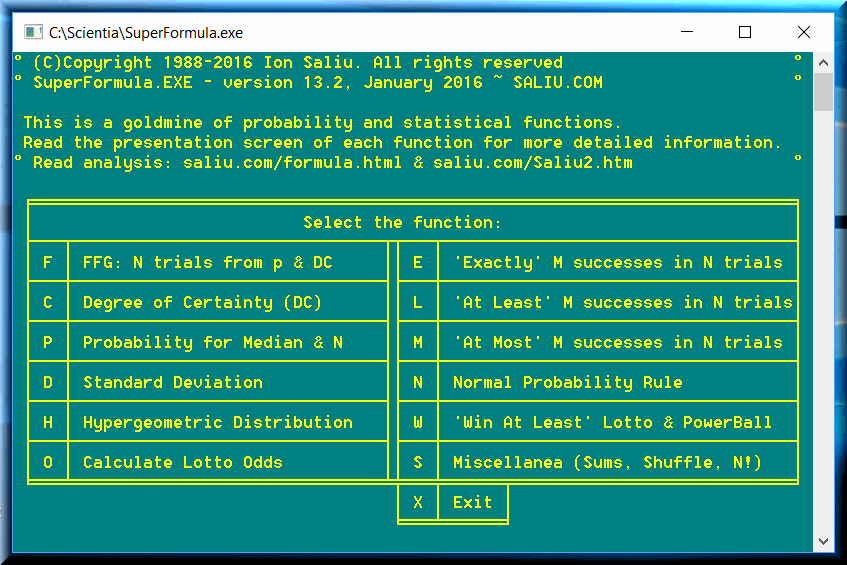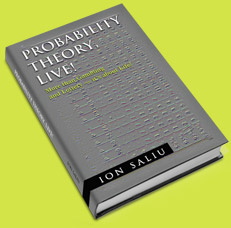
Bayes Theorem, Conditional Probabilities, Simulation, Surveys, Polling; Relation to Ion Saliu's Paradox
By Ion Saliu, Founder of: Probability Theory of Life, Randomness Philosophy




I. Formula to Calculate Conditional Probability
II. Simulation and Real Probabilities
III. Probability Rules of Multiplication and Addition
In our example: P(B|A) = [1/2 * 1/3] / [1/2] = [1/6] / [1/2] = 2/6 = 1/3.
Let's take a brute-force example: Elections in the United States. Let's say specialized organizations conducted surveys or exit polls. The figures that follow only attempt to be in step with reality.
The above figures can be referred to as probabilities of simultaneous events. We can try now to calculate conditional probabilities. When we know the voter is a man, what is the probability to vote Democrat?
P(B|A) = P(A and B) / P(A) = 48% * 60% / 48% = 28.8% / 48% = 60%.
Let's see the other side. We know the voter is a man, what is the probability to vote Republicab?
P(B|A) = P(A and B) / P(A) = 48% * 40% / 48% = 19.2% / 48% = 40%.
"Much ado about nothing," right? We already knew that Democrat would get 60%, while Republican would get 40%. Many find the conditional step to be futile. Why would I want somebody else tell me what suit a card was and then guess what value? The real probability means guessing in advance the color and value! Then, if I know what exact card was drawn, I can calculate the new probability.
Bayes' Theorem applies only to non-mutually exclusive events, such as determining probabilities from surveys or polls. The surveys and the polls are the only means of calculating probabilities as social events do NOT have predetermined formulas. Such events consist of two phases. They give examples such as drawing a card (a Jack) from a deck. Then the experiment conductor tells the subject that the result was a face card; what is the probability that the picture card was a Jack? That experiment does NOT have two phases — and it should NOT be given as an example of applications of the Bayes Theorem. Lottery is in the same category.
The best application of the Bayes Theorem is polling. It is widely applied in the political campaigns in the United States. Polling is the most typical case of a probabilistic event in two phases. Polls show quite accurate data how various segments of population vote. But nobody can predict the voter turnout.
More controversial chances are compiled by insurance companies to determine the risk. For example, the risk probability for a potential customer to suffer from cancer, when they know the would-be customer is a man. The Bayes Theorem simply amplifies the numbers and gives the impression of wider discrepancies. Blind faith in statistical data can lead to discrimination or racial profiling. Statistics are faulty numerous times…
Even the simplest cases, where the probability p = 1/2 (e.g. coin tossing) lead to… misleading simulations. If we toss the coin twice (number of trials N = 2), we expect the heads to appear once. NOT!! The degree of certainty that heads will appear is only 75%. We simulate 2 coin tosses and tails appears twice. Heads did not show up — is it probability 0 (zero)? NOT!!
In the case of tossing a coin, the lexicographical generating will look like this:
Heads
Tails
Take the example of elections. There is no way to generate all possible outcomes in lexicographical order. Only polling can give an idea of outcome probabilities. There are, indeed, situations when lexicographic order generating is not possible, as the real probability isn't known. In such cases, an extremely large amount of elements is necessary in random generation. An intermediary probability p1 can be determined. Then, that value p1 should be multiplied by 0.63 to get a value closer to the real probability p.
In the case of roulette, a random simulation of 37 spins (for all possibilities on the roulette wheel), only 24 unique numbers will appear. The Ion Saliu Paradox limit for roulette is 0.65. We will divide 24 by 0.65 and the result is 36.9. The 1/36.9 figure is very close to the real roulette probability of 1/37.
The famed Fundamental Formula of Gambling (FFG) offers the best and most accurate method of determining the real probability from a randomly generated statistical series. We only need to generate as many random outcomes as we can think of — the more, the better.
The key point is the repeat of elements in random events. The Ion Saliu's Paradox is, in fact, derived from the Fundamental Formula of Gambling (FFG). Half of the elements will repeat after a number of trials N less than or equal to the FFG median.
Let's say I generate some 2000 pick-3 lottery sets and track how many number of trials it took for every set to repeat. We have another series of statistical data consisting of the number of trials N. My lottery software does it very easily. The software then sorts the N data series and discovers the median of the series. I call it FFG median: The value in the middle of the N data series. That value is closely around 690. Keep in mind, several pick 3 sets will not come out in 2000 “drawings” (sets generated). Some sets will show up after 3000, or 4000, even after 5000 number of trials. The Bayes Theorem will conclude that those particular sets do not exist (as their probability appears to be 0)!
Next, I run the great piece of probability software SuperFormula (by Ion Saliu, of course!) The function we need is P = Probability for FFG Median and Number of Trials N. I enter as degree of certainty DC the value of 50 (for 50%, which is the middle). For Number of Trials N I type 690 (the number in the middle of the N series). The result: 1 in 995.96 or very, very close to the real probability of 1 in 1000 for a pick 3 lottery game.

Ion Saliu's Paradox also determines an acceptable value of the famous large numbers or long run in stochastic events. If the event has a probability p expressed as 1/N, then generating N * 50 elements randomly satisfies the long run requirement. The today's computers say that every possible element will appear IF generating N * 50 random elements. In the case of a 6 of 49 lotto game, that means 13983816 * 50 = 699,190,800 random combinations.
1) Bayes' Theorem dealt with conditional probabilities and simultaneous events. The calculation for probability of simultaneous events involves the rule of multiplication. In blackjack, for example, the house edge is determined by the simultaneous bust for player and dealer. Since the bust (following the dealer's rules) is 33%, the chance for simultaneous busts is 33% * 33% = 11%. The player gets a few bonuses that may reduce the house advantage to some 7% (the best case scenario for players!)
2) There is also another important probability rule: Addition. It applies to mutually exclusive and non-mutually exclusive events.
2.1) In the case of two mutually exclusive events A, B, the probability that A or B will occur is the sum of the probability of each event.
In our political example, the probability for a voter being man or woman is 48% + 52% = 100%. Evidently! The probability to get face 4 or point-face 6 when casting the dice is 1/6 + 1/6 = 2/6 = 1/3.
2.2) In the case of two non-mutually exclusive events A, B, the probability that A or B will occur is the sum of the probability of each event, minus the probability of the simultaneous event.
In our political example, we have a more complicated case: The probability to be a white or vote Democrat. This is a non-mutually exclusive event; it is not an either – or situation, as in coin-tossing. This specific chance is calculated as: P(A or B) = 60% + 60 % – 36% = 84%.
These three essays deal with probability topics, with a lot of help from computers and software:
Theory of Probability: Best Introduction, Formulas, Algorithms, Software
Fundamental Formula of Gambling, Probability, Mathematics, Degree of Certainty, Chance
Mathematics of Fundamental Formula of Gambling, Logarithms, God
Read Ion Saliu's first book in print:  Probability Theory, Live!
Probability Theory, Live!
~ Founded on valuable mathematical discoveries with a wide range of scientific applications, including probability theory applied to simulation and Bayes' Theorem.

Home | Search | New Writings | Odds, Generator | Contents | Forums | Sitemap
